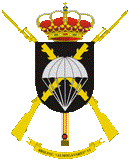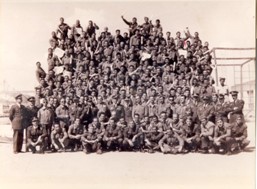MENÚ UNIDAD
ARMY UNITS
- Araba Álava |
- Albacete |
- Alicante |
- Almería |
- Asturias |
- Ávila |
- Badajoz |
- Barcelona |
- Burgos |
- Cáceres |
- Cádiz |
- Cantabria |
- Castellón |
- Ceuta |
- Ciudad Real |
- Córdoba |
- A Coruña |
- Cuenca |
- Girona |
- Granada |
- Guadalajara |
- Gipuzkoa |
- Huelva |
- Huesca |
- Islas Baleares |
- Jaén |
- León |
- Lleida |
- Lugo |
- Madrid |
- Málaga |
- Melilla |
- Murcia |
- Navarra |
- Ourense |
- Palencia |
- Las Palmas |
- Pontevedra |
- La Rioja |
- Salamanca |
- Segovia |
- Sevilla |
- Soria |
- Tarragona |
- Santa Cruz de Tenerife |
- Teruel |
- Toledo |
- Valencia |
- Valladolid |
- Bizkaia |
- Zamora |
- Zaragoza

Background
- pagination
-
The 6th Paratroopers Brigade “Almogávares” received its name from the Almogavar warriors of Spain in the 13th and 14th centuries; light infantry accustomed to making incursions deep into enemy territory and operating in the farthest reaches of the Mediterranean. Heir to the traditions of our Tercios, its closest historical link is with the Spanish Legion. The title of Sir/Lady Paratrooper Legionnaire (CLP/DLP, in Spanish), is a great incentive for its members; one which encourages them to identify with the Spanish Legion’s military traditions.
The 1st Army Parachute Battalion was created by reserved order of the Minister of the Army on October 17, 1953, and Major Tomás Pallás Sierra was assigned as its first commander. The battalion, stationed in the historic city of Alcalá de Henares (Madrid), was given the name ‘Roger de Flor’ and adopted the Fleur de Lis as its emblem, the symbol used by its famous namesake.
These new forces were activated on February 23, 1954, at the Air Force’s “Méndez Parada” Military School of Parachuting, in Alcantarilla (Murcia), during the paratrooper course. Events are held every year on that day to commemorate that historic date.
After two intense years of training and instruction, participation in numerous exercises demonstrated the Battalion’s great capacity as a combat unit, which is why the Group of Parachute Battalions of the Army was activated at the end of 1955.
Lieutenant Colonel Ignacio Crespo del Castillo took command of the newly activated Group of Battalions and began organizing the 2nd Parachute Battalion, which took the name of another famous Almogavar leader, ‘Roger of Lauria’.
THE GROUP OF BATTALIONS

Given the excellent results obtained by the Battalion in exercises and maneuvers, and with the creation of 2nd Battalion already underway, an ARMY PARACHUTE BATTALION GROUP was created in 1955. Infantry Lieutenant Ignacio Crespo del Castillo was appointed to command this group. Major Ramón Soraluce Goñi was appointed to command of the 2nd Battalion. Major Pallás continued at the head of the 1st Battalion.
This year also saw the first participation of paratroopers in Holy Week in Alcalá de Henares, Málaga and Álora.
THE SIDI IFNI CAMPAIGN (1957-1958)
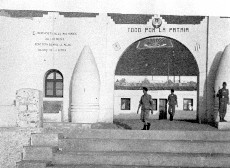
In April 1956, due to the instability of the Ifni region—invaded and traversed by "uncontrolled gangs"—, it was deemed necessary to reinforce this territory. The Command decided that the 1st Battalion should be transferred to Ifni. This was done immediately, but curiously not by plane, but by truck to Cádiz, and from there to Puerto del Rosario, in the Canary Islands. On July 9, the 1st Battalion, in full force, was sent to Sidi Ifni, where it disembarked on July 25. In January 1957, it was relieved by the 2nd Battalion. The unstable peace that had reigned in the area was broken by the first military incidents with armed gangs and irregular forces in the territory.
On May 8th, a Junker - 52 plane carrying a 2nd Battalion’s parachute patrol crashed and caught fire, killing Lt. José Cañada Armengol of the 9th Company; Corporal Juan Vargas Muñoz; Paratrooper Legionnaires Carlos Ramos Suárez de Urbina, José Benítez García, Luís Cabo Hidalgo, Manuel Tabares Vargas and José Gómez Pazos, and Paratrooper Legionnaire José Cuesta Manzano of the 6th Company. Corporal Ángel Canales López obtained the Individual Military Medal for his heroic behavior and courage in rescuing the survivors from the plane wreckage; Lt. José Sáez de Sagaseta of the 10th Company was awarded the War Cross (Cruz de Guerra) for his remarkable actions. These were the first casualties in Africa and also the first medals awarded.
On August 16, the parachute forces had their baptism of fire in Tiuisit-Igurramen and their first soldier wounded in combat, CLP Vicente Vila Pla of the 7th Company.
Meanwhile, the incidents and skirmishes with "uncontrolled gangs" continued to occur and the 2nd Battalion was put on alert at dawn on November 23rd. Given the desperate situation of the Z´Telata post, a section of the 7th Company, under the command of Lieutenant Antonio Ortiz de Zárate y Movellán, was sent to reinforce it. This order was met by the now famous reply of Lt. Ortiz de Zárate, uttered before leaving on the mission: "We will march into Z'Telata, or into heaven." The mechanized section was surrounded by the enemy and a fierce struggle began on the 24th to take a height three kilometers from Z´Telata. It proved impossible to continue on towards the post, and Corporal José Civera Comeche and Paratrooper Legionnaires Ramón Aguirre Ejidua and Manuel Rodríguez Matamoros fell in combat. On the 26th, Lt. Ortiz de Zárate’s platoon received heavy fire from automatic weapons and some one hundred enemy soldiers attempted to assault their position, being repelled and suffering some 40 casualties. Lt. Ortiz de Zárate and CLP Vicente Vila Pla were killed during the attack, and Sergeant Juan Moncada Pujol took command of the Platoon, being able to hold the position until reinforcements arrived under the command of the 1st Ifni Marksman Group on December 2nd. Over ten harrowing days of hardship and uncertainty, the Platoon suffered 5 men killed and 14 seriously wounded. Lt. Ortiz de Zárate and Sergeant Moncada were awarded the Individual Military Medal, while the rest of the Platoon received the Collective Military Medal.
During the siege of Lt. Ortiz de Zárate’s platoon, Operation "Pañuelo" was launched on November 29th with the aim of reinforcing the Tiliuin detachment. This first ‘War Jump’ was completed with no casualties and involved a daring parachute drop from 200 meters, in an area surrounded by enemy forces, under the command of Captain Juan Sánchez Duque of the 7th Company.
The 1st Battalion ‘marched to the sound of the guns’, and at the beginning of December the entire Group of Parachute Battalions had moved into Ifni Territory.
The paratroopers remained on the front line from the very first moments of the war. First in the “Netol” and “Gento” operations for the liberation of all the besieged posts. Later, in January 1958, in the “Diana” operation, forming the First Battalion in the “Agrupación Sur”, and in February, in the “Sirocco” and “Pegaso” operations, which cleared the Ifni territory of the “uncontrolled” bands. With Operation Pegaso, the second combat jump takes place under the command of Captain Prudencio Pedrosa Sobral of the 1st Company.

The group's baptism of fire left 37 dead (4 officers and 33 enlisted men) and 70 wounded (9 officers, 1 NCO and 60 enlisted men).
The year 1958 was spent clearing the area of infiltrated groups, escorting convoys and establishing advanced posts to avoid new infiltrations.
On April 24th, the 2nd Battalion returned to Alcalá de Henares. On December 4th, Lt. Col. José García Manuel took command of the group.
Fragment of the letter sent to Lieutenant Colonel Crespo del Castillo on December 16th, 1957, by General Zamalloa, Governor General of Spanish West Africa.
"Never has a new Unit begun its war record as brilliantly as this hitherto inexperienced Parachute Group. We must honor their fighting spirit, their magnificent physical prowess—shown whenever a supreme effort was required—and their courage, which has been on full display in every operation the Group has undertaken. We can well say that these heroic, new paratrooper legionnaires are brimming with the heroic soul of the glorious Spanish Legion and the bravery and courage of our infantry”.
TILUIN, FIRST WAR JUMP
The aerial landing at the besieged fort of Tiliuin (Ifni) was the first Spanish parachute action against a real enemy. Located 60 kilometers from the capital of the territory (Sidi Ifni) and due to the obstacles involved in conducting a land operation over such difficult terrain, the Commander decided to employ the "young parachute forces" and Operation "Pañuelo" was launched. The enemy that was active in the area—the rebels of the self-styled liberation army—had between 2,000 and 2,500 men scattered in different groups.
From the early hours of November 23rd, 1957, the Tiliuin fort was subjected to continuous attacks by rebel groups. The Asaca River—the border with French Morocco—was very close and, ever respectful of international law, our air force did not cross it, this area then being used by the enemy for shelter.
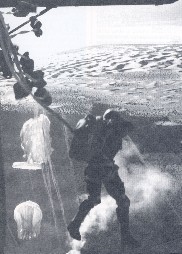
The parachute operation received the go-ahead at 10.00 p.m. on November 28th, 1957, and took place in the early hours of the 29th. The purpose was to carry out an aerial landing with parachute forces in the area of the Tiliuin aerodrome to establish contact with the garrison of the fort and reinforce it, allowing time for the Land Tactical Group to arrive, the personnel to be evacuated and the fort to then be destroyed.
The mission was assigned to the 7th Parachute Company—now down one platoon (that of Lt. Ortiz de Zárate)—, then stationed in the vicinity of the Zoco de Tzelata. Five Junker 52 aircraft were assigned for the operation, while direct air support was provided by five Heinkel 111 aircraft. The air landing was carried out in two rotations, the first consisting of five patrols of 15 men under the command of Captain Sánchez Duque, the second with the supplies, mortars and ammunition.
Both the launch and the aerial fire support were highly precise operations. At ten hours sixteen minutes, the first Heinkel took off and the rest at four-minute intervals, each plane with a specific bombing mission, over Intlan, Agadir, Morabtien, Sidi El Ahsen and all the houses that surround the north, west and south of the fort. The parachute drop then began and, with the support of the Heinkel machine guns, almost all the paratroopers reached the ground at their intended points. They were met by enemy machine gun fire from the Agadir area, the patrol where Captain Sánchez Duque jumped being the closest to this area. The enemy, thinking that these paratroopers intended to encircle Intlan and Agadir, deployed towards the east and south. In the end, the paratroopers managed to regroup and enter the fort without suffering a single casualty.
Over the following days, the rebels attacked the fort with mortars and rifles, until on December 3rd, at 10.00 p.m., contact was established with forces of the Spanish Legion.
On December 4th, with all the objectives fulfilled, the Spanish flag was lowered and, in the following hours, the fort was destroyed and the Unit returned to Sidi Ifni.
So ended the first war jump of the Army’s Parachute Units.
ERKUNT, SECOND WAR JUMP
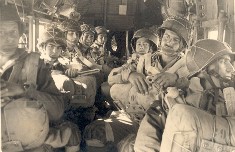
As part of the "Pegaso" operation, the second war jump of the Army's Parachute Forces took place in the vicinity of the town of Erkunt, on February 19th, 1958.
With a series of parachute drops to the north of the territory (Group “C”), the command intended, to secure the coastal highway linking the territory from north to south. Once this objective was achieved, the units were to withdraw to Sidi Ifni.
In addition to the parachute drops, a group (Group “M”) was drawn up by land, comprised of the 2nd Parachute Battalion and the 6th Battalion of the Spanish Legion, which would advance along the heights of the coastal communication route.
This column’s advance was ham
pered by enemy fire, forcing them to take some of the heights overlooking the landscape, giving rise to intense clashes with a considerable number of casualties between the forces of the Spanish Legion and the paratroopers.
Faced with the resistance of the liberation forces, the command, sure that the only possibility of surprising the enemy was to attack them from behind, ordered the forces of the 1st Company to embark under the command of Cap. Pedrosa, along with a machine gun platoon from the 5th Company, commanded by Lt. Antón Ordóñez.
The jump was made in the Erkunt D/Z, the closest to Sidi Ifni of those planned in the operation. Upon reaching the launch area, Cap. Pedrosa was the first in the patrol to jump, followed by the rest of his company, the jump being a success and taking place without incident. The objectives were achieved and the enemy was forced to withdraw.
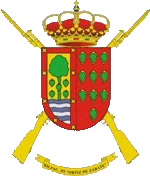
CREATION OF THE 3RD BATTALION
The 3rd Paratroopers Battalion was created in 1960, drawing on 230 paratroopers of the 1st Battalion (1st and 2nd Companies). It was assigned the name "Ortiz de Zárate"—in memory of the lieutenant of the 6th Company who fell at Ifni—, adopting the coat of arms of the Zárate family. Its first commander was Major Manuel Echánove Goñi.
In 1960, the Instruction Company was created, reporting to the 3rd Battalion, under the command of Captain Calvo Fernández. This Unit was the basis for the creation in February 1961 of the Depot and Instruction Unit, later the Parachute Instruction Battalion (1971) until its dissolution on December 31st, 2002.
ACTIONS IN THE SAHARA

In March 1961, a group of civilian engineers specialized in oil prospecting in the Sahara province was kidnapped by uncontrolled gangs, launching the so-called "oil conflict". The 2nd Battalion was transferred to the city of Smara, and, while positions were taken and its action was organized, the 1st Brigade was transferred to El Aaiún. The two parachute units collaborated with the Legion and the Nomadic Troops with an agile, discontinuous and dissuasive presence that allowed the territory to recover its normality. Once this stage was completed, the three Brigades underwent continuous rotations between the Peninsula, the Canary Islands and the Sahara.
In 1975, during the incidents that led to Spain’s decolonization of the Saharan territories and that ended with the so-called "Green March", the Hausa post, garrisoned by a unit of the 3rd BPAC, was attacked on August 2nd, resulting in the death of Corporal Ibarz Catalá.CREATION OF THE BRIPAC
At the beginning of 1965, it was decided that the Battalions would be commanded by lieutenant colonels instead of majors. The first of these were Pascual Galmes for the 1st, Blanco Blanco for the 2nd, and Echanove for the 3rd, and in February 1965 the Army’s Paratroopers Brigade was organized under the command of General Julio Coloma Gallegos. It took the three existing Battalions as its base and essential core, integrating elements from each of the combatant arms, as well as Service Support elements, which guarantee autonomous logistical support:
• Headquarters unit.
• 1st Paratroopers Battalion "Roger de Flor"
• 2nd Paratroopers Battalion “Roger de Lauria ”
• 3rd Paratroopers Battalion “Ortiz de Zárate”
• Anti-tank Company.
• Artillery Group.
• Mixed Engineer Battalion.
• Logistics Group.
• Centralized Majority.
• Depot and Instruction Unit.
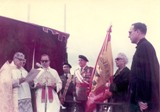
On February 14th, 1968, the National Flag was granted to the Unit, and was delivered on May 2nd of the same year by the mayor of Alcalá de Henares in a solemn act that was attended by the Prince and Princess of Spain, with the mother of Lieutenant Ortiz de Zárate acting as the act’s patron. In 1971, the Parachute Training Battalion was created in the Santa Bárbara camp in Javalí Nuevo (Murcia), which inherited and expanded the tasks of the Depot and Training Unit with the aim of relieving the Brigade of non-operational missions. Until it was disbanded on December 31st, 2002, the BIP was the true school where aspiring Paratrooper Legionnaires were forged.
BRIPAC INTERNATIONAL MISSIONS
Spain's entry into NATO triggered a program for the development and modernization of our Armed Forces and the assumption of international security and defense commitments.
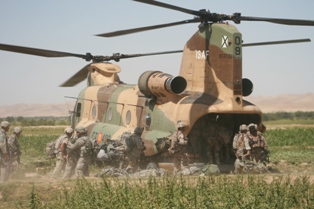
As of 1988, Spanish soldiers began collaborating in international missions and participating in various observer teams of the United Nations Organization in Africa, specifically in Angola, within the UNAVEM mission.
So began a journey that began with the dispatch of the "Roger de Flor" Battalion to Iraqi Kurdistan in 1991. It was the first time that a Spanish military unit was sent outside the National Territory.
From this moment on, BRIPAC personnel and units have participated in practically all the missions that the Spanish Armed Forces have carried out abroad, forming military units in: the former Yugoslavia, Kosovo, Mozambique, Iraq, Afghanistan, Pakistan, Lebanon and Mali.
Individual components in Observer missions: in UNAVEM (Angola), ONUSAL (El Salvador), ECCM (former Yugoslavia), among many other missions, which had a virtually unknown forerunner in the SPANISH HEALTH MISSION IN SOUTH VIETNAM, which deployed in that country between 1966 and 1971 with various rotations. Its goal was to provide health care at the Go-Cong hospital, a town located in the Mekong River delta. During the different rotations, there was participation from health personnel and a quartermaster captain (liaison officer and mission administrator) assigned to BRIPAC.
In 1991, the 1st Paratrooper Battalion, reinforced by the 7th Company of the 2nd Battalion, elements of the Logistics Group, the Launch Group, sapper and signals sections of the extinct Mixed Parachute

Engineer Battalion, together with other units of our Army, participated in operation “Alfa-Kilo” (Provide Comfort), sponsored by the UN to help the Kurdish people, in the so-called Tactical Group (AGT) "Alcalá".
In 1992, a Logistics Support Unit (UAL) and a unit of engineers participated in support of the AGT “Málaga”, in the former Yugoslavia.
Sapper personnel of this unit also participated in support of the AGT "Canarias", in 1993, in the same territory of Bosnia and Herzegovina (BiH), losing a sergeant and three paratrooper legionnaires during the mission.
In 1993, the AGT "Madrid", created on the basis of the BRIPAC, remained in Bosnia and Herzegovina, under the auspices of the United Nations for seven months, as a consequence of the ethnic clashes between the different peoples that inhabit the province of the former Yugoslavia.
The Brigade returned to BiH in May 1996, forming the bulk of SPABRI II, under a NATO mandate as part of IFOR (Implementation Force Peace), contributing to the effort to achieve peace in these Balkan lands. They remained in the operational zone until December of that same year.
In 1999, during the months of April and August, the Brigade carried out a new mission in BiH, forming the 10th SPABRI. During the mission, Sergeant Cabrejas Gil was killed.
In 2000, the 3rd Paratroopers Battalion and the 6th UZAPAC formed the bulk of the 2nd KSPABAT and the 2nd KUING, in Kosovo, forming part of the Multinational Brigade led by Italy.
From September 2001 to March 2002, the 2nd BPAC and UZAPAC formed the bulk of the 6th KSPAGT Group in Kosovo.
In 2003, the 1st BPAC, included in the 20th SPAGT, moved to the territory of Bosnia and Herzegovina, deploying in Mostar, remaining on mission between the months of May and November of that year.
Afghanistan was a central part of important pages in the history of BRIPAC, ever since, in 2004, the 3rd Brigade (9th ASPFOR), included in the ISAF, received the mission of protecting civilian personnel and facilities, during the elections in that country, deployed in the Mazar e Sharif area.The BRIPAC returned to Afghanistan in 2006, 2007, 2008, 2010 and 2012, this time in the Spanish province of Badghis.
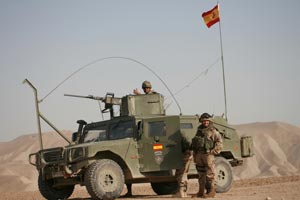
During their numerous deployments in this country, the actions carried out by the paratroopers have been rewarded with the granting of 14 Military Merit Crosses with a red badge (three of them posthumously), 4 Military Merit Crosses with a yellow badge and 30 Crosses to Military Merit with a blue badge, in addition to numerous citations in the General Order and multiple awards for valor.
In this territory, 4 paratroopers also gave their lives in the line of duty: Paratrooper Legionnaire Jorge Arnaldo Hernández Seminario (14th ASPFOR), Stanley Angelo Mera Vera and Germán Luis Pérez Burgos (17th ASPFOR); killed in various attacks against our forces. In addition, in 2012, during his deployment as a member of the mentoring and liaison team (4th OMLT CG 3/207), Senior Petty Officer Juan Medina Álvarez died of natural causes.
In 2007, the BRIPAC led the Spanish contingent for Lebanon, 2nd Libre Hidalgo (LH II), to enforce the UN agreements. During this deployment, on June 24th, our forces suffered an attack with a van bomb that killed six of our paratroopers. It returned to this mission in 2010 (11th contingent LH), 2016 (25th Libre Hidalgo) and 2020 (31st LH).
A new international deployment began in 2013. A mission under the flag of the European Union. BRIPAC began by participating in the European Union Training Mission in Mali (EUTM) where it participated with a protection unit. Subsequently, teams of fire support instructors were added to this unit. These teams are relieved by others from BRIPAC during 2014. It returned to this mission in 2018.
With the new concept of missions—instructing the host nation's army—, the BRIPAC deployed in 2015 in Afghanistan, integrated into the NATO mission Resolute Support. It returned to this country in 2018 with the same mission and in 2021 as a NATO Mission Iraq protection unit.
Today, the BRIPAC, with the new mission-oriented organization, as an immediate response and initial entry unit, continues its instruction and training to be deployed wherever Spain so demands.


